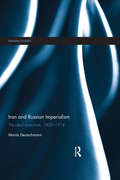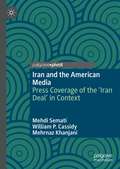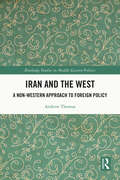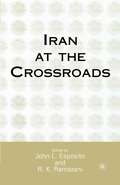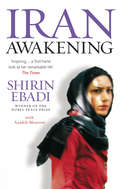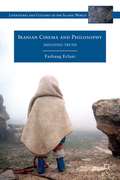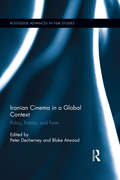- Table View
- List View
Iran and Russian Imperialism: The Ideal Anarchists, 1800-1914 (Iranian Studies)
by Moritz DeutschmannRather than a centralized state, Iran in the nineteenth century was a delicate balance between tribal groups, urban merchant communities, religious elites, and an autocratic monarchy. While Russia gained an increasingly dominant political role in Iran over the course of this century, Russian influence was often challenged by banditry on the roads, riots in the cities, and the seeming arbitrariness of the Shah. Iran and Russian Imperialism develops a comprehensive picture of Russia’s historical entanglements with one of its most important neighbours in Asia. It recounts how the Russian Empire strived to gain political influence at the Persian court, promote Russian trade, and secure the enormous southern borders of the empire. Using hitherto often neglected documents from archives in Russia and Georgia and reading them against the grain, this book reveals the complex reactions of different groups in Iranian society to Russian imperialism. As it turns out, the Iranians were, in the words of the Russian orientalist Konstantin Smirnov, "ideal anarchists," whose resistance to imperial domination, as well as to centralized state institutions more generally, impacted developments in the region in the century to come. Iran’s troubled relationship with the wider world continues to be a topic of considerable interest to historians, yet little focus has been given to Russia’s historical connections to Iran. This book thus represents a valuable contribution to Iranian and Russian History, as well as International Relations.
Iran and the American Media: Press Coverage of the ‘Iran Deal’ in Context
by Mehdi Semati William P. Cassidy Mehrnaz KhanjaniThis book investigates the American media coverage of the historic nuclear accord between the Islamic Republic of Iran and the world powers, commonly known as the Iran Deal. The analysis examines the sources of news and opinion expressed about the Iran Deal in The New York Times, The Washington Post and the national newscast of broadcast networks. The empirical component uses media sociology and indexing theory to determine the extent to which the media covered the topic within a framework of institutional debates among congressional leaders, the executive branch and other governmental sources. The coverage is placed within a larger historical and interpretative framework that examines the construction of Iran in both the pre-revolution news narratives and in the post-revolution American media and popular culture. The book endeavors to reveal the place Iran occupies in the American political and cultural imagination.
Iran and the Challenge of Diversity: Islamic Fundamentalism, Aryanist Racism, and Democratic Struggles
by Ailreza AsgharzadehThis interrogates the racist construction of Aria and Aryanism in an Iranian context, arguing that these concepts gave the Indo-European speaking Persian ethnic group an advantage over Iran's non-Persian nationalities and communities.
Iran and the Muslim World: Resistance And Revolution
by N. KeddieThis book consists of a series of interrelated chapters analyzing why Iran, among all countries, has seen so many revolutionary movements in the past century; the degree to which its religion, Shi'ism, is revolutionary; and the history of revolutionary and resistance movements in the modern Muslim world. The author stresses historical change, such as the change of Twelver Shi'ism from political quietism to revolutionary opposition, and also previously unnoticed factors in revolution, such as the multi-urban character of all Iran's modern revolutions.
Iran and the Nuclear Question: History and Evolutionary Trajectory (Iranian Studies)
by Mohammad HomayounvashSpanning over a period of more than five decades since its inception, Iran’s nuclear programme is the most protracted civilian nuclear program in the world and one of the most politicized projects in Iran’s history. 'Iran and the Nuclear Question' offers a historiographical portrait of Iran’s early nuclear program under Mohammad Reza Shah Pahlavi. Using declassified archival material, the book thematically chronicles the program’s genesis, evolutionary trajectory, and devolution from the 1950s through to the 1970s. It also catalogues the Revolutionary Iran’s early socialization into the atom and the Islamic Republic’s gradual change of heart about nuclear energy that culminated in the incremental resuscitation of the Shah’s nuclear enterprise in the 1980s. As the first archive-based account of one of the most long-lasting and capital-intensive nuclear enterprises during the Cold War, ‘Iran and the Nuclear Question’ is a valuable resource for students and scholars of Iranian, Middle East and Security Studies. Written in a clear and accessible format, it will also appeal to those with a more general interest in Iran and its nuclear journey.
Iran and the Nuclear Question: History and Evolutionary Trajectory (Iranian Studies)
by Mohammad HomayounvashSpanning over a period of more than five decades since its inception, Iran’s nuclear programme is the most protracted civilian nuclear program in the world and one of the most politicized projects in Iran’s history. 'Iran and the Nuclear Question' offers a historiographical portrait of Iran’s early nuclear program under Mohammad Reza Shah Pahlavi. Using declassified archival material, the book thematically chronicles the program’s genesis, evolutionary trajectory, and devolution from the 1950s through to the 1970s. It also catalogues the Revolutionary Iran’s early socialization into the atom and the Islamic Republic’s gradual change of heart about nuclear energy that culminated in the incremental resuscitation of the Shah’s nuclear enterprise in the 1980s. As the first archive-based account of one of the most long-lasting and capital-intensive nuclear enterprises during the Cold War, ‘Iran and the Nuclear Question’ is a valuable resource for students and scholars of Iranian, Middle East and Security Studies. Written in a clear and accessible format, it will also appeal to those with a more general interest in Iran and its nuclear journey.
Iran and the West: A Non-Western Approach to Foreign Policy (Routledge Studies in Middle Eastern Politics)
by Andrew ThomasThis book explores non-Western approaches to foreign policy in the context of Iran in order to encourage wider consideration of non-Western scholarship in international relations.Throughout its existence IR has drawn primarily on Western thought and experience, leaving other perspectives on the periphery of discourse. As the field becomes more about contexts beyond the West, this has become a challenge for creating a truly ‘global’ field of study. Concepts like ‘national interest,’ ‘rationality’ and ‘pragmatism’ are often applied to Iran without considering what these concepts mean in the context of Iranian political identity. The aim of this book is to highlight the contemporary relevance of native Iranian and non-Western perspectives to IR analysis, returning complexity and critique to Iranian studies. To do this, the author examines four of Iran’s political encounters with the West, including its resistance to sanctions policy and negotiations surrounding its nuclear program. Ultimately, the book argues that ignoring Iranian motivations of identity has routinely resulted in missed opportunities, growing tensions and failed coercive policy.The book will prove valuable reading for students and researchers interested in international relations theory, Iranian history and Middle East studies.
Iran and the West: A Non-Western Approach to Foreign Policy (Routledge Studies in Middle Eastern Politics)
by Andrew ThomasThis book explores non-Western approaches to foreign policy in the context of Iran in order to encourage wider consideration of non-Western scholarship in international relations.Throughout its existence IR has drawn primarily on Western thought and experience, leaving other perspectives on the periphery of discourse. As the field becomes more about contexts beyond the West, this has become a challenge for creating a truly ‘global’ field of study. Concepts like ‘national interest,’ ‘rationality’ and ‘pragmatism’ are often applied to Iran without considering what these concepts mean in the context of Iranian political identity. The aim of this book is to highlight the contemporary relevance of native Iranian and non-Western perspectives to IR analysis, returning complexity and critique to Iranian studies. To do this, the author examines four of Iran’s political encounters with the West, including its resistance to sanctions policy and negotiations surrounding its nuclear program. Ultimately, the book argues that ignoring Iranian motivations of identity has routinely resulted in missed opportunities, growing tensions and failed coercive policy.The book will prove valuable reading for students and researchers interested in international relations theory, Iranian history and Middle East studies.
Iran At The Crossroads: Global Relations In A Turbulent Decade
by Miron RezunThe chapters in this book were written by me or solicited from renowned experts to produce a work that anticipated an imminent post- Khomeini period in Iranian history. The first draft was not ready until June 1989, practically coinciding with the death of Khomeini and the tenth anniversary of the Iranian Revolution-an important milestone after a decade of turmoil. The book you are about to read took some time to put together. Based on extensive research, the project was undertaken in early 1988 and ended about the spring of 1990. A sincere debt of gratitude is naturally owed to all of my contributors. But the preparation of any book does not take place in a financial void. My gratitude is especially extended to the academic vice-president of my university, Dr. Robert Burridge, for granting me the seed money from the university's Development Fund. Substantial financial assistance to cover the bulk of the logistical expenses was offered by the Canadian Institute of International Peace and Security in Ottawa and by the Social Sciences and Humanities Research Council of Canada through its program of aid to scholarly conferences.
Iran At The Crossroads: Global Relations In A Turbulent Decade
by Miron RezunThe chapters in this book were written by me or solicited from renowned experts to produce a work that anticipated an imminent post- Khomeini period in Iranian history. The first draft was not ready until June 1989, practically coinciding with the death of Khomeini and the tenth anniversary of the Iranian Revolution-an important milestone after a decade of turmoil. The book you are about to read took some time to put together. Based on extensive research, the project was undertaken in early 1988 and ended about the spring of 1990. A sincere debt of gratitude is naturally owed to all of my contributors. But the preparation of any book does not take place in a financial void. My gratitude is especially extended to the academic vice-president of my university, Dr. Robert Burridge, for granting me the seed money from the university's Development Fund. Substantial financial assistance to cover the bulk of the logistical expenses was offered by the Canadian Institute of International Peace and Security in Ottawa and by the Social Sciences and Humanities Research Council of Canada through its program of aid to scholarly conferences.
Iran at the Crossroads
At the dawn of the 21st century, we are witnessing the redefining and reforming of the Islamic Republic, a struggle between the President Khatami's reformist agenda and more militant conservative forces led by Ayatollah Khameni, Iran's Supreme Religious Guide. The Islamic Republic of Iran at 20 is a place of new promises and aspirations whose political, economic ,and socioeconomic struggles have significance not only for Iranians but also for Iran's relations with the international community. Iran at the Crossroads provides an intimate view of Iran, domestically and internationally, and the current struggle to reconstruct and thus relegitimate the revolution. This volume includes essays by American, European, and Iranian scholars writing on the extraordinary changing situation in Iran today.
Iran Awakening: A memoir of revolution and hope
by Shirin EbadiIn this remarkable book, Shirin Ebadi, Iranian human rights lawyer and activist, and Nobel Peace Prize laureate, tells her extraordinary life story.Dr Ebadi is a tireless voice for reform in her native Iran, where she argues for a new interpretation of Sharia law in harmony with vital human rights such as democracy, equality before the law, religious freedom and freedom of speech. She is known for defending dissident figures, and for the establishment of a number of non-profit grassroots organisations dedicated to human rights. In 2003 she became the first Muslim woman, and the first Iranian, to be awarded the Nobel Peace Prize.She chronicles her childhood and upbringing before the Iranian Revolution, her education and student years at the University of Tehran, her marriage and its challenges, her religious faith, and her life as a mother and as an advocate for the oppressed. As a human rights campaigner, in particular for women, children and political prisoners in Iran, her autobiography is a must-read for anyone fascinated by the life story and beliefs of a courageous and unusual woman, as well as those interested in current events (especially those of the Middle East), and those who want to know the truth about the position of women in a Muslim society.
Iran between Islamic Nationalism and Secularism: The Constitutional Revolution of 1906 (British Institute of Persian Studies)
by Vanessa MartinWith the ratification of a new constitution in December 1906, Iran embarked on a great movement of systemic and institutional change which, along with the introduction of new ideas, was to be one of the most abiding legacies of the first Iranian revolution – known as the Constitutional Revolution. This uprising was significant not only for introducing secular understandings of government, but also Islamic visions of what could constitute a national assembly. The events of the Constitutional Revolution in Tehran have been much discussed, but the provinces, despite their crucial role in the revolution, have received less attention. Here, Vanessa Martin seeks to redress this imbalance. She does so firstly by analysing the role of the Islamic debate in the late nineteenth and early twentieth centuries, and its relationship with secular ideas, and secondly by examining the ramifications of this debate in the main cities of Tabriz, Shiraz, Isfahan and Bushehr. By exploring the interaction between Islam and secularism during this tumultuous time, Iran between Islamic Nationalism and Secularism concludes that in each province, the Constitutional Revolution took on a character of its own.
Iran Encountering Globalization: Problems and Prospects
by Ali MohammadiWith new material and up-to-date information, this book examines the current state of Iran, exploring a wide range of areas including the economy, finance, politics, the media, and the position of women and migration. Iran Encountering Globalization discusses the uneasy balance between the theocratic conservatism, modernization and globalization. This is a key tension in Iran - one which has arisen following the revolution of 1979, since the regime has worked to Islamicize the country, while at the same time international globalization forces have been pulling in a different direction. Concluding that forces for change in Iran are currently building up, this is an extremely topical book that makes an important contribution to current debates surrounding democracy in Iran.
Iran Encountering Globalization: Problems and Prospects
by Ali MohammidiWith new material and up-to-date information, this book examines the current state of Iran, exploring a wide range of areas including the economy, finance, politics, the media, and the position of women and migration. Iran Encountering Globalization discusses the uneasy balance between the theocratic conservatism, modernization and globalization. This is a key tension in Iran - one which has arisen following the revolution of 1979, since the regime has worked to Islamicize the country, while at the same time international globalization forces have been pulling in a different direction. Concluding that forces for change in Iran are currently building up, this is an extremely topical book that makes an important contribution to current debates surrounding democracy in Iran.
Iran in the 21st Century: Politics, Economics & Conflict (Iranian Studies)
by Homa Katouzian Hossein ShahidiIran is an ancient country, an oil-exporting economy and an Islamic Republic. It experienced two full-scale revolutions in the twentieth century, the latter of which had large and important regional and international consequences, including an eight-year war with Saddam Hussein’s Iraq. And now in the twenty-first century, it confronts issues and experiences problems which have important implications for its future development and external relations. Featuring outstanding contributions from leading sociologists, social anthropologists, political scientists and economists in the field of Iranian studies, this book is the first to examine Iran and its position in the contemporary world. In developing this argument, topics examined include: social developments in the country including gender relations contemporary politics international relations relations with the US and Israel nuclear weapons and energy programmes oil and the development of the economy.
Iran in the 21st Century: Politics, Economics & Conflict (Iranian Studies)
by Homa Katouzian Hossein ShahidiIran is an ancient country, an oil-exporting economy and an Islamic Republic. It experienced two full-scale revolutions in the twentieth century, the latter of which had large and important regional and international consequences, including an eight-year war with Saddam Hussein’s Iraq. And now in the twenty-first century, it confronts issues and experiences problems which have important implications for its future development and external relations. Featuring outstanding contributions from leading sociologists, social anthropologists, political scientists and economists in the field of Iranian studies, this book is the first to examine Iran and its position in the contemporary world. In developing this argument, topics examined include: social developments in the country including gender relations contemporary politics international relations relations with the US and Israel nuclear weapons and energy programmes oil and the development of the economy.
Iran, Iraq and the Arab Gulf States
by J. KechichianA decade after the War for Kuwait and two decades after the Iran-Iraq War, the wider Gulf region remains mired in internal, regional and international conflicts. Iran, Iraq, and the Arab Gulf States presents analytical perspectives - including solution-oriented assessments to identify major causes for actual and potential conflicts throughout the Gulf. The twenty-six papers assembled in this volume identify trends for the next decade. Studies on Iranian, Iraqi, Saudi and Arab Gulf States' political agendas on the domestic, regional and international fronts are included, along with assessments on pending legal issues, including border disputes, relations among the Gulf states themselves, as well as their complex and evolving ties with several Western powers. The study closes with four 'trends' chapters looking at the 2000-2010 period.
Iran, Iraq, and the Legacies of War
by L. Potter G. SickIraq and Iran are the two most important states in the Gulf region, given their population size, military strength, and the potential threat they pose to other states in the region. This book enhances our understanding of the troubled relationship between Iran and Iraq, placing it in historical context, examining the rapid deterioration leading to the eight-year war that started in 1980 and the effects of that trauma, and exploring the ongoing issues that currently bedevil bilateral relations. The authors cover such central issues as how each side has sought to use opposition groups in the other state to weaken it, ethnic divisions, the role of outside states (especially the United States), and a fascinating account of how the war affected a generation of Iraqis and Iranians. The role of the U.S. in the region and how U.S. policy has affected the two states are also considered. This book provides a basis for understanding the background of a tumultuous relationship that is entering a new era.
Iran Reframed: Anxieties of Power in the Islamic Republic (Stanford Studies in Middle Eastern and Islamic Societies and Cultures)
by Narges BajoghliAn inside look at what it means to be pro-regime in Iran, and the debates around the future of the Islamic Republic. More than half of Iran's citizens were not alive at the time of the 1979 Revolution. Now entering its fifth decade in power, the Iranian regime faces the paradox of any successful revolution: how to transmit the commitments of its political project to the next generation. New media ventures supported by the Islamic Republic attempt to win the hearts and minds of younger Iranians. Yet members of this new generation—whether dissidents or fundamentalists—are increasingly skeptical of these efforts. Iran Reframed offers unprecedented access to those who wield power in Iran as they debate and define the future of the Republic. Over ten years, Narges Bajoghli met with men in Iran's Revolutionary Guard, Ansar Hezbollah, and Basij paramilitary organizations to investigate how their media producers developed strategies to court Iranian youth. Readers come to know these men—what the regime means to them and their anxieties about the future of their revolutionary project. Contestation over how to define the regime underlies all their efforts to communicate with the public. This book offers a multilayered story about what it means to be pro-regime in the Islamic Republic, challenging everything we think we know about Iran and revolution.
Iran Revisited: Exploring the Historical Roots of Culture, Economics, and Society (Arts, Research, Innovation and Society)
by Ali PirzadehThis book examines Modern Iran through an interdisciplinary analysis of its cultural norms, history and institutional environment. The goal is to underline strengths and weaknesses of Iranian society as a whole, and to illustrate less prescriptive explanations for the way Iran is seen through a lens of persistent collective conduct rather than erratic historical occurrences. Throughout its history, Iran has been subject to many studies, all of which have diagnosed the country’s problem and prescribed solutions based on certain theoretical grounds. This book intends to look inward, seeking cultural explanations for Iran’s perpetual inability to improve its society. The theme in this book is based on the eloquent words of Nasir Khusrau, a great Iranian poet: “az mast ki bar mast”. The words are from a poem describing a self-adoring eagle that sees its life abruptly ended by an arrow winged with its own feathers—the bird is doomed by its own vanity. The closest interpretation of this idiom in Western Christian culture is “you reap what you sow”, which conveys a similar message that underlines one’s responsibility in the sense that, sooner or later, we must face the choices we make. This would enable us to confront – and live up to – what Iran’s history and culture have taught us.
Iran Today [2 volumes]: An Encyclopedia of Life in the Islamic Republic [2 volumes]
by Manochehr Dorraj Mehran KamravaIran dominates the media headlines once again and has taken center stage in the U.S. and European Union strategy toward the Middle East. A more nuanced understanding of Iranian society has assumed even greater significance and urgency. Iran Today: An Encyclopedia of Life in the Islamic Republic offers crucial insight for students and the general reader into an often misunderstood and complex country that is shrouded in mystery and misperception. Heir to a long history and a great culture and civilization, Iran embodies a rich, complex, and diverse mosaic that defines its national identity. Diversity is also the operative word that describes Iranian landscapes and geography, its multiple ethnic groups and their varied cultures and traditions, as well as the uneven and vastly different levels of economic and industrial development, conflicting political tendencies, and different and often contradictory social and cultural outlooks. Because of its tumultuous recent political history, Iran appears to encapsulate all of these internal differences and stark contrasts somewhat more distinctly than most of its neighbors. The 1978-1979 revolution transformed the society and culture in fundamental ways and redefined social life. It created new institutions of governance and Islamicized the culture, education and the legal system in an attempt to create a new society that would usher in the reign of piety and virtue. Yet, Islamization had to come to terms with pre-Islamic and illustrious Persian history and culture, as well as the realities of an interdependent, postmodern, globalized world in which, as a developing country, Iran resides in the periphery. Within this framework, the dynamics and complexity of social life in the Islamic Republic unfold. This encyclopedia is the source for up-to-date, authoritative information on a full range of critical topics of interest.Coverage of the Islamic Republic here falls into the general categories of history, politics, economics, society and culture. The most significant aspects of the life in Iran since the revolution-the era of the Islamic Republic so far-are stressed. The wide range of entries shows the richness and complexity of Iranian society, its multiple and varied facets, its expressions and outward manifestations, and its nuanced responses to political repression, instability, war, pervasive crisis and the chronic tension between modernity and tradition. Some of the entries designed to highlight these important phenomena revolve around the country's ethnic mosaic, the social role and position of women, veiling, the educational system, sports, intellectuals, the arts and artistic expression, literature, poetry, cuisine, healthcare, and the family. Other entries range from regionalism and urban development to the petroleum industry, agriculture, the banking system, issues of wealth and poverty, class structure and economic mobility, and the private sector. In a number of significant areas economic, social and cultural phenomena intersect. These intersections are reflected in entries on broadcasting and communications technology, the Internet, public relations, electronic and print media, and family planning and healthcare. A chronology, selected bibliography, and photos complement the entries.
#iranelection: Hashtag Solidarity and the Transformation of Online Life
by Negar MottahedehThe protests following Iran's fraudulent 2009 Presidential election took the world by storm. As the Green Revolution gained protestors in the Iranian streets, #iranelection became the first long-trending international hashtag. Texts, images, videos, audio recordings, and links connected protestors on the ground and netizens online, all simultaneously transmitting and living a shared international experience. #iranelection follows the protest movement, on the ground and online, to investigate how emerging social media platforms developed international solidarity. The 2009 protests in Iran were the first revolts to be catapulted onto the global stage by social media, just as the 1979 Iranian Revolution was agitated by cassette tapes. And as the world turned to social media platforms to understand the events on the ground, social media platforms also adapted and developed to accommodate this global activism. Provocative and eye-opening, #iranelection reveals the new online ecology of social protest and offers a prehistory, of sorts, of the uses of hashtags and trending topics, selfies and avatar activism, and citizen journalism and YouTube mashups.
Iranian Cinema and Philosophy: Shooting Truth (Literatures and Cultures of the Islamic World)
by Farhang ErfaniIn film studies, Iranian films are kept at a distance, as 'other,' different, and exotic. In reponse, this book takes these films as philosophically relevant and innovative. Each chapter of this book is devoted to analyzing a single film, and each chapter focuses on one philosopher and one particular aesthetic question.
Iranian Cinema in a Global Context: Policy, Politics, and Form (Routledge Advances in Film Studies)
by Peter Decherney Blake AtwoodIranian films have been the subject of much critical and scholarly attention over the past several decades, and Iranian filmmakers are mainstays of international film festivals. Yet most of the attention has been focused on a small segment of Iranian film production: auteurist art cinema. Iranian Cinema in a Global Context, on the other hand, takes account of the wide range of Iranian cinema, from popular youth films to low budget underground films. The volume also reassesses the global circulation of Iranian art cinema, looking at its reception at international festivals, in university curricula, and at the Academy Awards. A final theme of the volume explores the intersection between politics and film, with essays on post-Khatami reform influences, representations of ineffective drug policies, and the representation of Jewish characters in Iranian film. Taken together, the essays in this volume present a new definition of the field of Iranian film studies, one that engages global media flows, transmedia interaction, and a heterogeneous Iranian national cinema.
